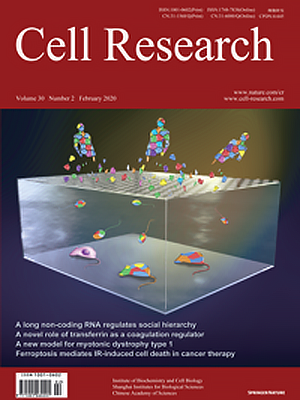
Volume 30, No 2, Feb 2020
ISSN: 1001-0602
EISSN: 1748-7838 2018
impact factor 17.848*
(Clarivate Analytics, 2019)
Volume 30 Issue 2, February 2020: 179-181
LETTERS TO THE EDITOR
Cryo-EM structure of a type I-F CRISPR RNA guided surveillance complex bound to transposition protein TniQ
Zhuang Li 1, Heng Zhang1, Renjian Xiao1 and Leifu Chang 1,2
1Department of Biological Sciences, Purdue University, West Lafayette, IN 47907, USA and 2Purdue University Center for Cancer Research, West Lafayette, IN 47907, USA
These authors contributed equally: Zhuang Li, Heng Zhang
Correspondence: Leifu Chang (lchang18@purdue.edu)
Dear Editor,
CRISPR-Cas systems provide adaptive immunity in prokaryotes through RNA-guided cleavage of mobile genetic elements and have been harnessed as powerful genome editing tools. A programmable guide RNA and the effector Cas protein are delivered to mammalian cells to create double strand breaks on the target sequence in the genome, triggering endogenous DNA repair pathways that enable genetic changes. However, recent studies revealed transposon-associated CRISPR-Cas systems that are inactive in target cleavage but direct transposases for RNA-guided DNA transposition.1,2,3,4 Those findings open a new paradigm for precise DNA insertion independent of DNA repair pathways.1,2 RNA-guided DNA integration in type I-F CRISPR-Cas system from Vibrio cholerae requires the DNA-targeting Cascade complex (also called the Csy complex) that is composed of Cas6, Cas7, a natural fusion of Cas8 and Cas5 (Cas8/5), and a 60-nt crRNA, along with the transposition machinery including TnsA, TnsB, TnsC and TniQ (a homolog of TnsD) (Fig. 1a). TniQ binds to the Vibrio cholerae Cascade complex (VcCascade) and recruits the core TnsABC machinery for transposition, thus playing an essential role in transposition. To understand the molecular basis if the RNA-guided DNA integration process, we determined the structure of VcCascade bound to TniQ at 3.1 Å resolution by cryo-EM (Fig. 1b, c; Supplementary information, Figs. S1–3, and Table S1). The resultant maps are of sufficient quality for accurate atomic model building for VcCascade and TniQ, except for the helical bundle of Cas8/5 which is built as a poly-alanine model (Fig. 1b).
https://doi.org/10.1038/s41422-019-0268-y
FULL TEXT | PDF
Browse 1033


